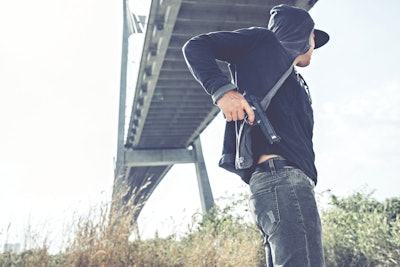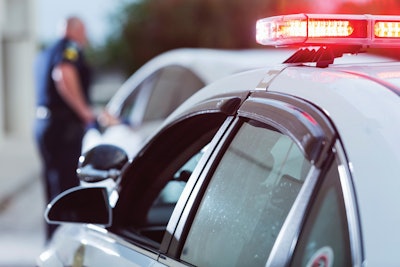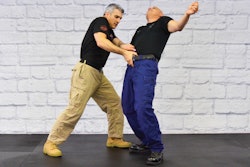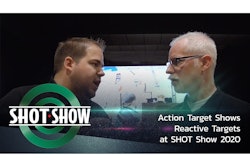 When under attack, the most important thing is to move. A sitting duck is an easy target.Photo: Getty Images
When under attack, the most important thing is to move. A sitting duck is an easy target.Photo: Getty Images
"Victorious warriors win first and then go to war, while defeated warriors go to war first and then seek to win." —Sun Tzu
This article is a compilation of officer safety advice from my own training and experience and from some of the best trainers I know. Parts of it may seem elementary to you. But some of the reports on ambush murders of police officers show that we are repeating our mistakes.
When Under Attack
The most important thing is to move. A sitting duck is an easy target.
If you are in a patrol car, use it to get out of the kill zone or as a weapon to eliminate the threat. If you are on foot, run fast and get to a spot where you can accurately shoot. Running and gunning looks cool, but it may not be the best choice. You will naturally slow down when shooting, making you an easy target. And firing from a full-tilt run will make your shots inaccurate.
Communication
Use communications effectively. Get the best info possible before searching for suspects or advancing on them. Know who your backup is and where your backup is. Radio time is precious. It will be jammed. Clear the air for those who need it. Do not direct backup into the kill zone.
Approaching a Scene
Slow down and take a tactical pause. Stop, look, and listen. This one small act can save your life and make you able to more effectively address the situation. Evaluate what is going on. This is true whether you are in a patrol car or on foot. In police work, time and distance is most always your friend.
Binoculars are a great tool for viewing a scene at distance. Keep them in the seat next to you and not in the trunk. When you study the scene, identify cover and identify people moving around. And remember that the incident is not always limited to the location to which you were dispatched. You could have been given information, or the incident could have gone mobile.
Avoid kill zones and cross fires. When hunting the suspect do not have multiple officers encircle him. That could create a blue-on-blue tragedy.
Stabilize Yourself
Gain control of yourself. Adrenaline can work against you. Combat breathing, otherwise known as autogenic breathing, can help control your heart rate and your fear. To perform combat breathing, inhale for a four-count, hold for a four-count, exhale for a four-count, hold for a four-count.
In Your Vehicle
The patrol vehicle can give you a false sense of security. It has become our office, but unless it is armored it is not a safe haven or place of refuge during an ambush. Our admins have given us a computer, a stereo, a cell phone, and everything we need to do police work from the comfort of a car seat. But don't type your reports in the car. Type them in your station. If you must stay on the street, meet a partner in a spot with a long approach and wide field of view. And have your partner watch your six. You should both park in a manner that makes for a fast getaway. Unbuckle your seat belt so you can exit your car quickly if you need to.
 Tactical medical gear and the knowledge of how to use it is a must for every modern warrior guardian.Photo: Getty Images
Tactical medical gear and the knowledge of how to use it is a must for every modern warrior guardian.Photo: Getty Images
Think about lighting. Dim the interior lights and your computer screen. Use bright headlights to temporarily blind someone approaching you from the front.
Lock your doors. That will slow an intended attacker and limit access to you. Crack your windows so you can hear people and vehicles approaching. Look around frequently, using mirrors to scan 360 degrees.
Many patrol units now carry a ballistic shield. Is yours in the trunk? It shouldn't be. Put it behind your driver seat with a bungee cord or strap. That way it can provide ballistic protection for your back and spine while you are driving out of harm's way.
Speaking of ballistic protection, your vehicle is not great cover, unless it has been armored. Tests have shown cars are generally poor cover. The engine block is the only protection in an unarmored vehicle.
When driving, don't get hemmed in at a stoplight or in traffic. Leave yourself room to get out if attacked. Check mirrors often, both when parked and driving.
Finally—and I realize this is not Officer Friendly-like and may be met with some opposition from those who insist we become more kind and gentle—do not let someone approach you while you are sitting in your patrol car. Ask them to stay back and then either exit safely or move the car so that you can do so. Of course, good threat assessment and situational awareness will serve you well here. Use your cop sixth-sense and ability to size people up quickly to your advantage. Remember that there is a way to speak to people without offending them. A well-placed "sir" or "ma'am" can do wonders in this situation.
Talking to People
Always have a plan. Always be assessing cover.
Maintain a safe gap/positioning. Make sure you are positioned to allow for a quick response to a physical attack. If confronted with a gun while up close, do you try to outdraw the suspect's trigger squeeze? Remember that action is quicker than reaction, and that makes the likelihood of winning unlikely. Do you go hands-on first to redirect the suspect's gun, access yours, and react to deadly force with deadly force? Have you trained in techniques to do so? In addition to physical training in these tactics, mental rehearsal is a must.
Traffic Stop Tactics
Consider a passenger-side approach or a callout approach. There are numerous advantages to the passenger-side approach. It does something the suspect/driver is not used to, and can provide the element of surprise. It gives the officer a view of the driver's right hand. Ninety percent of the population is right-handed and people tend to handle weapons with their strong hand. If a driver is planning to ambush you once you arrive at the car door, the passenger side can give you the tactical advantage by providing you better options for cover and/or concealment, greater distance, and more reaction time.
When faced with a situation that gives you the tingle (driver making a furtive move, not stopping right away, numerous passengers), consider a "no approach," or callout tactic.
When a driver or passenger exits the car, be especially wary when the last part of them to exit the car is their right hand. That is not normal behavior and they are concealing it for a reason.
As for remaining seated in the car because your computer and ticket-writing equipment dictates it, always call a backup. Lone officers can be dead officers. It is unacceptable to allow it to become commonplace. Yes, I know this will affect manpower and cut activity somewhat, but officer safety takes priority.
Sniper Incidents
During a sniper attack, get to cover because he is hunting you. Move from cover if your position becomes tactically inferior. If you must move, stay low and use short sprints from cover to cover. Use the radio. Let your backup(s) know your location, the suspect's location and description, and the type of weapon the suspect is using.
If you are in a vehicle, a quick turn down another street, into a driveway or other space may get you out of the kill zone. If none of those options exist, is a sidewalk drivable? Can you get into a secure building by breaking a door or window?
When the suspect has the high ground, and you are in a car, drive rapidly through it. You will be a more difficult target. Some officers might immediately stop, reverse, or U-turn. That might slow you or stop you, which gives the suspect a chance to hit you.
In Restaurants
I like my back to a wall, so no one can walk behind me, but that is not always possible. Plus, a lot of people know that's "the cop seat," and they can spot you. If you are off-duty or working plainclothes, consider avoiding it. Whether in uniform or plainclothes, use a table, not a booth, so you can move more quickly out of it. Stay away from window seats. When sitting with multiple officers, communicate your respective area of responsibility such as front door, rear door, etc. Watch people when they enter. Look for squirrely behavior, the thousand-yard stare, the target stare, bulges in clothing, manner of clothing (does it fit the weather?), and unusual gait.
Watch how other cops act in these situations to learn what not to do. Many remain oblivious to the world around them. They are entranced by their phone or by their computer. I recently walked into a coffee shop and saw two law enforcement officers sitting right by the front door, buried in their laptops. Neither even gave me—an armed man—a second look when I entered the front door.
In the Station
Attacks in police stations and the parking lots of stations have been numerous in recent years, so we must consider it an eventuality and prepare for it.
Parking immediately around the building must be restricted. Access control is a must. Fencing, speed humps, and stanchions or other barriers can help. Exteriors and interiors should be well lit. The use of video cameras provides cheap insurance in the form of an early warning system or deterrent. Agencies should provide a way for officers and other personnel to see what they are walking into when exiting the station. A ballistic window or camera with monitor can provide that.
Attacks have happened at the front desk area. Make sure the front windows and door are not covered by numerous posters and other promotional material. Officers at the front desk need to see what's happening outside.
Front desk personnel should be fully uniformed, wear body armor, and have all equipment required for patrol. They should also be in good enough health to fight back if necessary. The desk officers are literally the first line of defense for your stronghold.
Officers must be mindful of threats when entering and exiting headquarters. Threats can occur anyplace, and the best spot for an ambush is where someone least expects it and is not mentally prepared for it.
At Home
Make sure you are not being followed home. A few left turns will help you identify a threat. Also, don't drive home via the same route every day.
When you arrive home, stop, look, and listen. Does everything appear normal? Assess the situation. An enemy could be awaiting your return, as eagerly as your family dog, except with a much more sinister intent. Speaking of dogs, they are a great deterrent.
Similarly, when you leave your house don't walk out of the front door or garage door thinking you are still in your safe zone because you are at home. When you walk out that door, get your head in the game. And be sure to check the outside through a window or two before proceeding out into the world.
Checking the yard and surrounding areas before exiting is a good practice for your family also. Preparing your family with some basic safety skills—beyond that of normal parent and husband/wife stuff—is important. Your family is different. They are a law enforcement family, and with that comes risk for which they must prepare. It is your job to prepare them.
Finally, take every legal step available to keep your internet profile as low as possible. I don't have a presence on Facebook; I use my wife's account. If you must have your own social media, use an assumed name and keep your account limited to good friends only. Don't post trophy pictures, uniform photos, or blue line content.
Take full advantage of any state statutes regarding the confidentiality of law enforcement officer information. In Florida, for example, it is illegal to make public the addresses and other personal information of police and corrections officers. A confidentiality form must be filed with a local property appraiser's office, as well as the clerk and comptroller's office for civil and criminal court records to ensure your personal information is redacted—including your address—before release under public records law. Similarly, make use of the opt-out option on websites that routinely collect and sell personal information. In some cases, I have had to send certified letters to those companies advising them of the law. You may need to "Google" yourself regularly to stay ahead of the information superhighway, but it is worth it. If someone wants to come after you, don't make it easy for them.
Essential Equipment
Tactical medical gear and the knowledge of how to use it is a must for every modern warrior guardian. Tourniquets and pressure bandages should be carried and readily accessible. Know buddy/self-care. If you are wounded, and under fire, EMS is not coming to get you.
Extra ammo is important. Lots of law enforcement officers keep these items in a bailout bag or "go" bag. Consider carrying extra body armor, plates, external vests, and other protective gear. No one should go in service without a superior weapon these days. Binoculars and night vision can be a big help as well.
Vehicle armor is becoming more readily available to agencies. It is also possible to equip patrol cars with perimeter warning systems to alert officer occupants to the approach of a person, especially in blind spots. These systems also come with options for alarms that are deafening to temporarily incapacitate a potential attacker and give the intended victim officer a momentary tactical advantage.
Mindset
A proper mindset is possibly the most important thing you need to prevail in an ambush. Do not underestimate your attacker. They have prepared. Have you?
To prepare, watch videos of ambushes and formulate a response plan in your own head. Visualization is a powerful tool. It programs your body and mind for success.
What training have you taken? Shooting on the move is a skill essential to winning a gunfight. Take courses that involve dynamic scenarios using marking rounds to inoculate yourself against fear and pain.
Prepare, because your day will come.
Lt. Pete Ebel has served as a law enforcement officer for 31 years, and currently works narcotics for a large south Florida sheriff's office. He is a veteran trainer who helped build the Team One Network's Counter-Ambush Instructor course.














